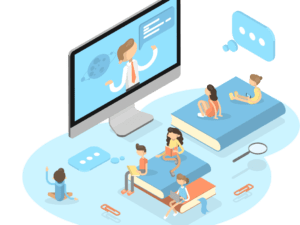🦉 Multilingualism Platforms for 🎓 Teaching and Language Learning Course in the Digital Age
- Description
- Curriculum
- Reviews

The Language Learning Platform is an innovative and engaging tool that makes learning a new language fun and accessible for everyone. This course is designed to help teachers effectively integrate the Language Learning Platform into their curriculum, and to provide students with the skills they need to become proficient in a new language.
Throughout the course, you will have the opportunity to participate in hands-on activities such as Desk Slam and Bonfire, which will allow you to see the Language Platform in action. You will also have the opportunity to share best practices and troubleshoot common issues with your fellow teachers.
The Language Platform is a valuable tool for schools, teachers, students, and parents. It allows students to learn a new language in a fun and interactive way while providing teachers with the tools they need to track student progress and customize the learning experience. Additionally, parents can monitor their children’s progress checking their devices and supporting their language learning journey
Language Learning Course outline
- We will introduce the Language Platform and its features. You will learn about the benefits of using the Language Platform in the classroom and how it can help to create a more dynamic and engaging learning experience for students.
- We will focus on setting up a Language Platform classroom. You will learn how to create a teacher account, add students to a class, and customize class settings. We will also provide you with a step-by-step guide on how to set up your own Language Platform class.
- We will cover the management of assignments. You will learn how to create and assign lessons, track student progress, and set up class leaderboards. We will also cover the use of the reports tab and exporting, student privacy settings, and the student experience.
- We will discuss the importance of teaching and learning multilingualism in today’s world and for the profession of the future. We will also show you a fun and effective way to learn a language using the Language Platform.
- We will explore how to use the Language Platform in the classroom. You will learn how to incorporate the Language Platform into lesson plans, use it as a supplement to traditional language instruction, and use it as a formative or summative assessment.
- We will focus on bite-sized lessons and real-world communication skills. You will learn how to use the Language Platform to gain real-world communication skills, combine the best of AI and language science, and form a language learning habit with game-like features, fun challenges, and reminders from our friendly mascot.
- We will explore lessons focusing on real-life goals and mini-stories that challenge your reading and listening comprehension. We will show you how the Language Platform can help learners to develop the vocabulary and grammar needed to achieve that goal through lots of varied practice in reading, writing, listening, and speaking.
- We will cover best practices and troubleshooting. You will learn tips for maximizing student engagement and success, common issues, and how to resolve them.
- We will summarize the key takeaways and provide additional resources for further learning.
In conclusion, this course is designed to help you make the most of the Language Platform and to provide your students with the skills they need to become proficient in a new language. The Language Platform is an excellent tool for creating a more engaging and dynamic learning experience for students, and this course will provide you with the knowledge and skills you need to make the most of it.
-
1🟢👉 SKS Online Course guide, tips, and emojis meaning list
Start from here, with our online course guide, tips, and emojis meaning list
-
2🤝🎧💡 Multilingualism: Switch to English and benefits
Welcome to this lesson on the benefits of being bilingual or multilingual. Being fluent in multiple languages has many advantages, including improved cognitive skills, enhanced memory and recall, and a delay in age-related cognitive decline. In this lesson, we will discuss the various benefits of being bilingual or multilingual and provide strategies for helping individuals learn additional languages. We will also explore the impact of multilingualism on children, including the benefits of exposing children to multiple languages at an early age and the role of music and technology in language learning. By understanding the benefits of being bilingual or multilingual, individuals can take steps to learn and improve their language skills, setting themselves up for success in a rapidly changing and globally connected world.
-
3Overview of the Language Platform and its features
-
4Benefits of using the Language Platform in the classroom
-
5Teacher Activity: Watch a demo of the Language Platform and explore its features
-
6🌍🎓🎧💡 English CLIL: Effective Teaching Strategies and benefits for Content and Language Integrated Learning
In this lesson, we will explore strategies for teaching using CLIL, including planning and preparing lessons, providing scaffolding and support, assessing student learning, and creating a positive and inclusive learning environment. Content and Language Integrated Learning (CLIL) is a teaching approach that involves using a foreign language, such as English, as the medium of instruction for non-language subjects. This approach can be used to teach a variety of subjects, including science, math, history, and more.
-
7🎓 Gamification methodology for teaching
Gamification is a teaching method that uses game elements and design in non-game contexts to engage and motivate students. It can be used to increase student engagement and motivation, as well as to teach specific skills or concepts.
-
8🎓🤦♂️🎧🔗🔑💡 Understand the role of technology and challenge in education in the 21st century
Technology plays a significant role in parenting and education in the 21st century. It offers numerous benefits and opportunities for learning and communication, but it also requires careful consideration and management to ensure children are safe and responsible online.
-
9🎓🤦♂️🎧💡🔗🔑 Using Technology in Education: tips and trends
In this lesson, we will explore the importance of technology in education and discuss why it is a vital part of the learning process. We will also provide tips for using technology wisely in education, including purposeful integration, balance, digital literacy, and more. Additionally, we will present ten arguments for why technology is essential in education, covering topics such as preparing students for society, providing job skills, closing the digital divide, and teaching digital natives. Finally, we will offer ideas and activities for learners to engage with and learn more about the role of technology in education.
-
10🔝💼👩🔬🎧👨🎓🎓🤦♂️💡 The Fourth Industrial Revolution, the impact on Education and Career
The Fourth Industrial Revolution has the potential to bring significant benefits, but it also requires careful consideration of the ethical and social implications. It is important for businesses, individuals, and policymakers to understand the potential impact of these technologies and to work together to ensure that they are used responsibly and for the benefit of society as a whole.
-
11🆕🔍👨🎓👩🔬🎧💡🎓🤦♂️🔑🔗 Career exploration and the role it plays in finding a fulfilling career
One important aspect of this exploration is researching and considering different career and industry options. There are many new jobs that will be in high demand in the next 5-10 years, as well as those that may not have a future due to automation. According to various sources such as Forbes, Monster, and Glassdoor, there are several markets that are expected to thrive in the coming years.
-
12👨🎓🤝🎧🎓💡 Learning to Think
Neil deGrasse Tyson's life advice is about empowering others to think independently and critically, about making the world a better place, and about creating meaning in our own lives. He encourages us to always be learning, to never be satisfied with the status quo, and to always strive to make a positive impact on the world.
-
13👾💡👉 Join our Open Discord Server to share your progress, engage with other and peer review your activities
Join us on our open server to share your progress and ask questions, engage and have fun with others and receive feedback. On the server, there are specific channels for each topic, where you can share your content and read what other members and course authors have posted. This is a great way to connect with others with the same passions and learn from each other's experiences and insights.
-
18Creating and assigning lessons
-
19Tracking student progress
-
20Setting up and using class leaderboards
-
21Using the reports tab and exporting
-
22Student Privacy settings
-
23The student experience
-
24Desk slam: Using the Language Platform with the smartboard
-
25Bonfire: Work in groups with limited number of devices
-
26Other activities: Messenger and Catch them all!
-
27Teacher Activity: Assign a lesson, explore the reports tab and student privacy settings, and try out different activities such as Desk Slam and Bonfire
-
31Incorporating the Language Platform into lesson plans
-
32Using the Language Platform as a supplement to traditional language instruction
-
33Using the Language Platform as a formative or summative assessment
-
34Teacher Activity: Plan a lesson using the Language Platform and integrate it into your curriculum
-
35Bite-sized lessons, you’ll earn points and unlock new levels while gaining real-world communication skills.
-
36Form a habit of language learning, with game-like features, fun challenges, and reminders from our friendly mascot
-
37Effective learning doesn’t have to be boring! Build your skills each day with engaging exercises and playful characters.
-
38Teacher Activity: Have students work on the Language Platform and give them feedback on their progress
-
39Lessons focus on a real-life goal — for instance, ordering at a restaurant.
-
40Learners develop the vocabulary and grammar needed to achieve that goal through lots of varied practice in reading, writing, listening, and speaking.
-
41Mini-stories that challenge your reading and listening comprehension
-
42Allows learners to discover patterns on their own without needing to focus on language rules — the same way you learned your first language as a child.
-
43Teacher Activity: Have students work on a real-life goal scenario and use mini-stories to challenge their reading and listening comprehension
















